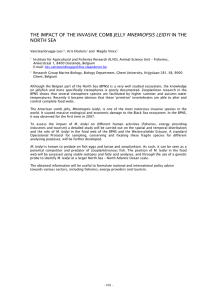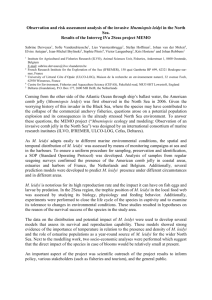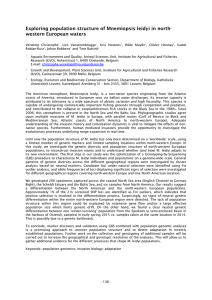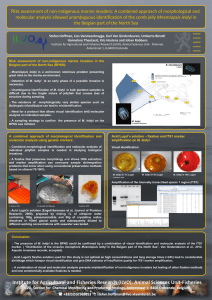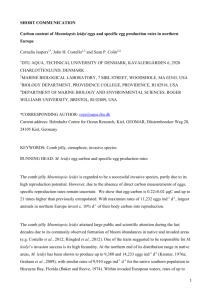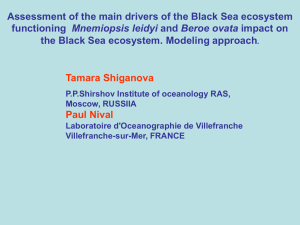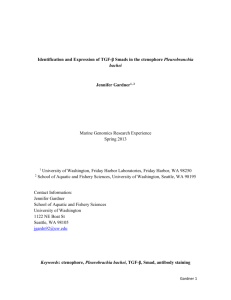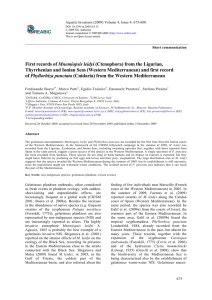Aquatic Invasions (2012) Volume 7, Issue 2: 163–169 Open Access
advertisement
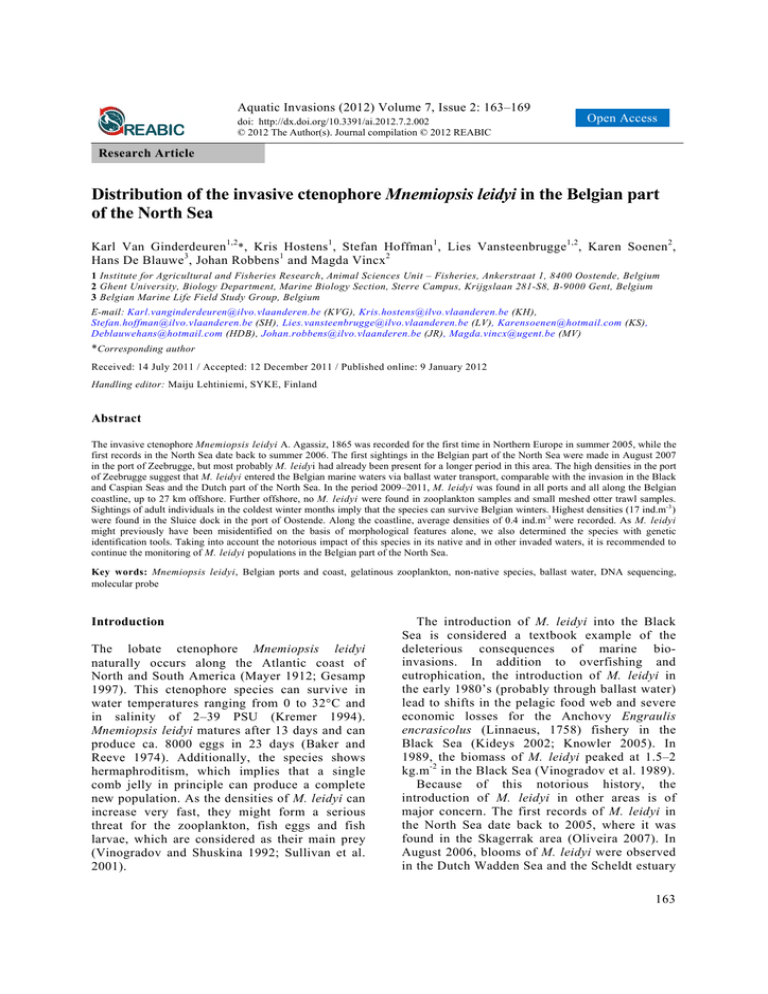
Aquatic Invasions (2012) Volume 7, Issue 2: 163–169 doi: http://dx.doi.org/10.3391/ai.2012.7.2.002 © 2012 The Author(s). Journal compilation © 2012 REABIC Open Access Research Article Distribution of the invasive ctenophore Mnemiopsis leidyi in the Belgian part of the North Sea Karl Van Ginderdeuren 1,2*, Kris Hostens1, Stefan Hoffman 1, Lies Vansteenbrugge1,2, Karen Soenen 2, Hans De Blauwe3, Johan Robbens1 and Magda Vincx 2 1 Institute for Agricultural and Fisheries Research, Animal Sciences Unit – Fisheries, Ankerstraat 1, 8400 Oostende, Belgium 2 Ghent University, Biology Department, Marine Biology Section, Sterre Campus, Krijgslaan 281-S8, B-9000 Gent, Belgium 3 Belgian Marine Life Field Study Group, Belgium E-mail: Karl.vanginderdeuren@ilvo.vlaanderen.be (KVG), Kris.hostens@ilvo.vlaanderen.be (KH), Stefan.hoffman@ilvo.vlaanderen.be (SH), Lies.vansteenbrugge@ilvo.vlaanderen.be (LV), Karensoenen@hotmail.com (KS), Deblauwehans@hotmail.com (HDB), Johan.robbens@ilvo.vlaanderen.be (JR), Magda.vincx@ugent.be (MV) *Corresponding author Received: 14 July 2011 / Accepted: 12 December 2011 / Published online: 9 January 2012 Handling editor: Maiju Lehtiniemi, SYKE, Finland Abstract The invasive ctenophore Mnemiopsis leidyi A. Agassiz, 1865 was recorded for the first time in Northern Europe in summer 2005, while the first records in the North Sea date back to summer 2006. The first sightings in the Belgian part of the North Sea were made in August 2007 in the port of Zeebrugge, but most probably M. leidyi had already been present for a longer period in this area. The high densities in the port of Zeebrugge suggest that M. leidyi entered the Belgian marine waters via ballast water transport, comparable with the invasion in the Black and Caspian Seas and the Dutch part of the North Sea. In the period 2009–2011, M. leidyi was found in all ports and all along the Belgian coastline, up to 27 km offshore. Further offshore, no M. leidyi were found in zooplankton samples and small meshed otter trawl samples. Sightings of adult individuals in the coldest winter months imply that the species can survive Belgian winters. Highest densities (17 ind.m-3 ) were found in the Sluice dock in the port of Oostende. Along the coastline, average densities of 0.4 ind.m-3 were recorded. As M. leidyi might previously have been misidentified on the basis of morphological features alone, we also determined the species with genetic identification tools. Taking into account the notorious impact of this species in its native and in other invaded waters, it is recommended to continue the monitoring of M. leidyi populations in the Belgian part of the North Sea. Key words: Mnemiopsis leidyi, Belgian ports and coast, gelatinous zooplankton, non-native species, ballast water, DNA sequencing, molecular probe Introduction The lobate ctenophore Mnemiopsis leidyi naturally occurs along the Atlantic coast of North and South America (Mayer 1912; Gesamp 1997). This ctenophore species can survive in water temperatures ranging from 0 to 32°C and in salinity of 2–39 PSU (Kremer 1994). Mnemiopsis leidyi matures after 13 days and can produce ca. 8000 eggs in 23 days (Baker and Reeve 1974). Additionally, the species shows hermaphroditism, which implies that a single comb jelly in principle can produce a complete new population. As the densities of M. leidyi can increase very fast, they might form a serious threat for the zooplankton, fish eggs and fish larvae, which are considered as their main prey (Vinogradov and Shuskina 1992; Sullivan et al. 2001). The introduction of M. leidyi into the Black Sea is considered a textbook example of the deleterious consequences of marine bioinvasions. In addition to overfishing and eutrophication, the introduction of M. leidyi in the early 1980’s (probably through ballast water) lead to shifts in the pelagic food web and severe economic losses for the Anchovy Engraulis encrasicolus (Linnaeus, 1758) fishery in the Black Sea (Kideys 2002; Knowler 2005). In 1989, the biomass of M. leidyi peaked at 1.5–2 kg.m-2 in the Black Sea (Vinogradov et al. 1989). Because of this notorious history, the introduction of M. leidyi in other areas is of major concern. The first records of M. leidyi in the North Sea date back to 2005, where it was found in the Skagerrak area (Oliveira 2007). In August 2006, blooms of M. leidyi were observed in the Dutch Wadden Sea and the Scheldt estuary 163 K. Van Ginderdeuren et al. (Faasse and Bayha 2006). Prior to these sightings, autumn blooms of lobate ctenophores identified as Bolinopsis infundibulum O.F. Müller, 1779 - were reported in the Netherlands (Holsteijn 2002). However, B. infundibulum is a cold water species considered rare along the Dutch coasts. As morphological identification is indeed difficult for related ctenophores, it remains uncertain whether these earlier sightings of B. infundibulum could have been misidentified M. leidyi. It is recommended that ‘older’ ctenophore observations in the North Sea are considered with some precaution. This illustrates the need for an unambiguous identification with genetic tools. Based on different nuclear and mitochondrial genetic biomarkers, these tools can be used for species identification and even the delineation of different populations (Gorokhova and Lehtiniemi 2010; Reusch et al. 2010). In Autumn 2006, M. leidyi was also found in the German part of the North Sea near Helgoland (Boersma et al. 2007) and the Baltic Sea near Kiel (Javidpour et al. 2006). Mnemiopsis leidyi was observed for the first time in the Belgian part of the North Sea (BPNS) in August 2007, where it was found at high numbers in the port of Zeebrugge (Dumoulin 2007). In this paper, we present the observation of M. leidyi in several docks within the ports of Nieuwpoort, Oostende and Zeebrugge, and at ten mesozooplankton monitoring stations in the Belgian part of the North Sea (Figure 1). Ctenophores were caught using plankton nets, fish trawls and dip nets. The individual species were identified both morphologically and genetically. Methods Ctenophore sampling Ctenophores were sampled in the ports, coastal and offshore areas of the Belgian part of the North Sea with a variety of methods. Between August 2008 and March 2011, qualitative data were monthly gathered by the Belgian Marine Life Field Study Group in the Ports of Nieuwpoort, Oostende and Zeebrugge (Figure 1). These data mainly consist of non-standardized visual inspections from the shore, mostly combined with hand gathering using dip nets. In the Sluice dock (1.5 m deep, situated in the port of Oostende), an additional quantitative sampling was performed in October 2010 at four 164 sampling locations, with a rigid inflatable boat towing a WP2 plankton net (57 cm diameter, 1 mm mesh size, fitted with a flow meter) at 2 knots just below the water surface. Biovolumes of M. leidyi in the Sluice dock were measured with a graduated cylinder. From January 2010 to December 2010, monthly mesozooplankton samples were taken with a WP2 net (57 cm, 200 µm mesh size, fitted with a flow meter) towed in an oblique haul from bottom to surface at ten monitoring stations in the Belgian part of the North Sea (Figure 1). Although, similar samples were gathered in 2009, these could not be used for this study, as the whole zooplankton samples were fixed in 4% formaline solution, in which Mnemiopsis species dissolve. In 2010, the sampling protocol was adapted, with all ctenophores extracted and quantified prior to sample fixation. Between January 2009 and December 2010, an otter trawl was used at the same ten sampling locations on the BPNS to investigate whether there were dense aggregations of Mnemiopsis close to the seabed. The trawl has a net opening of 3×1 m, net mesh size 10 mm, and was dragged over the seafloor for 30 minutes at 3 knots. Ctenophores were directly identified onboard. A binocular stereomicroscope was used for small or damaged specimens. From January 2011 to March 2011, quantitative data on M. leidyi were gathered with a WP3 net (1 m diameter, 500 µm mesh size, fitted with a flow meter) at stations W01-04-0709 in the BPNS (Figure 1). The WP3 net was towed along a curvilinear trajectory (net going down and up the water column (undulating) twice, at a net speed of 3 knots) to sample a representative cross-section of the water column. The WP3 net is more suited to look for Mnemiopsis occurring in low densities than a WP2 net, as it filters much bigger water volumes. Morphological species identification All ctenophores were identified alive onboard. Intact ctenophores from plankton trawls and dip nets were measured (total length in mm, including lobes) to determine the size range. The most important morphological feature characterizing M. leidyi is the extent of the oral lobes (Figure 2). The oral lobes of M. leidyi extend over almost the entire body and reach the statocyst (the apical sense organ), whilst in the Mnemiopsis leidyi in the Belgian part of the North Sea Figure 1. The port, nearshore and midshore peak densities of Mnemiopsis leidyi found in this study, with highest densities in the Sluice dock of Oostende. A) North sea Exclusive Economic Zones; B) Belgian part of the North Sea, with ten stations (nearshore W01-04, midshore W05-07, offshore W08-10) sampled monthly for zooplankton (black dots), and ports specifically sampled for Mnemiopsis leidyi (triangles). The Sluice dock is part of the Oostende port (cross). Figure 2. A) Mnemiopsis leidyi from the marina in the port of Zeebrugge (23/9/2009, © Hans Deblauwe); B) Mnemiopsis leidyi from the German Bight (29/1/2010, © Karl Van Ginderdeuren); C) Mnemiopsis leidyi from the Sluice dock in Oostende (22/10/2010, © Karen Soenen). The oral lobes (1) are important for morphological identification, where for M. leidyi they extend over almost the entire body reaching the statocyst (2). 165 K. Van Ginderdeuren et al. similar species Bolinopsis infundibulum, the oral lobes terminate between the mouth and the statocyst. The extent of the oral lobes was verified for each individual lobed ctenophore. Molecular analysis Ctenophores from locations W01-02-03-05 sampled in September 2010 were selected for molecular analysis (Appendix 1). Each individual was preserved separately in 70–100% ethanol and stored at 4°C till genetic analysis. Genomic DNA was extracted from the gelatinous lobe tissue using the Genomic DNA extraction Wizard® (Promega). Molecular species identification was done by amplifying and sequencing the internal transcribed spacer (ITS) DNA sequence as a genetic biomarker with primers KN8-9-11 (Fuentes et al. 2010; Ghabooli et al. 2011). Base calling and sequence assembly for ca. 420bp fragments was done with the Bionumerics software 6.5™ (Applied Maths). Positions showing two peaks were coded as degenerated and given a DNA IUB ambiguity code. Sequence identity was evaluated performing a NCBIBLASTN search against the sequences present in the GenBank. Results Between August 2008 and March 2011, Mnemiopsis leidyi were seen in the ports of Nieuwpoort, Oostende and Zeebrugge, the nearshore stations W01-02-03-04 and the midshore stations W05 and W07 (Appendix 1, Figure 1). No individuals of M. leidyi were caught in midshore station W06 and the offshore stations W08-10 (>30 km from the coast). Highest densities were noted in the Sluice dock in Oostende. In all cases the oral lobes of the ctenophores reached the position of the statocyst, which positively identified them as M. leidyi (Figure 2). The individuals that were measured ranged between 1 and 6 cm in total length. Bolinopsis infundibulum was not found among the ctenophores. The specimens that were genetically characterized, showed a similarity score of 99–100% with the ITS sequences from M. leidyi clones present in the Genbank. Query coverages ranged from 80–100%. Other hits showing lower similarity scores included Pleurobrachia sp. (96% 166 similari-ty, 43% query coverage), Bolinopsis sp. (95% similarity, 100% query coverage), and Beroe sp. (92% similarity, 72% query coverage). In agreement with the morphological identification, the molecular results also identified the ctenophores as M. leidyi. Mnemiopsis leidyi was not found between November 2009 and June 2010. For the rest of the studied period, the species was found in all seasons. Even in the coldest winter months, adult Mnemiopsis were present in the ports and near/midshore, at water temperatures as cold as 2°C. Peak densities were observed in October 2009 and 2010, with M. leidyi found at all sampled locations except offshore stations (Appendix 1). Based solely on the WP2 zooplankton samples where M. leidyi occurred in 2010, a yearly average density of 0.4 (±SD 0.2) ind.m-3 was calculated. The WP3 samples from January and February 2011 showed very low densities of M. leidyi, on average 0.01 ind.m-3. The highest density at sea was 0.8 ind.m-3 at the nearshore station W01 (Zeebrugge) and midshore station W05 (Gootebank) in October 2010. M. leidyi was recorded in the otter trawl samples only in October 2009 and 2010. In October 2010, densities were similar to those in the zooplankton samples: on average 0.37 and 0.29 ind.m-3, respectively. In the Sluice dock (port of Oostende), M. leidyi appeared to be common in Autumn 2010, with an average density of 9.7 ± 6.5 ind.m-3 (peak density 16.8 ind.m-3) on 22nd October, and an average biovolume of 24.8 ± 17.6 ml.m-3. Discussion Marine invasions are considered a major threat for the world’s oceans. Ballast water conveys marine species on a worldwide scale. It is estimated that the annual amount of 3.4 billion tons of ballast water moves some 7000 species around the world at any given time (Carlton 1985; Clarke et al. 2003; Globallast 2007). Transferred species can establish reproductive populations in the host environment, outcompeting native species and multiplying into pest proportions. Currently, 68 marine ‘invasive’ species (e.g. algae, crustaceans, cnidarians) have established persistent populations in the Belgian part of the North Sea (Kerckhof et al. 2007; VLIZ 2007). Mnemiopsis leidyi in the Belgian part of the North Sea It is possible that Mnemiopsis leidyi has been introduced into the North Sea through a secondary invasion from the Baltic Sea (Reusch et al. 2010). However, the fact that M. leidyi was first seen within the port of Zeebrugge strongly supports the hypothesis that the species was brought in directly via ballast water transport in cargo ships, comparable with the invasions of M. leidyi in the Black and Caspian Seas (Vinogradov et al. 1989; Ivanov et al. 2000), and as indicated for the Dutch part of the North Sea (Faasse and Bayha 2006). Given the high densities upon discovery in the port of Zeebrugge, it is likely that the species was already present for several months before August 2007. Molecular analysis confirmed the morphological identification of M. leidyi in the Belgian part of the North Sea. However, efforts must be undertaken to increase the genetic data on ctenophores, as the number of corresponding ITS sequences in GenBank for different ctenophores such as Beroe sp., Bolinopsis sp. and Pleurobrachia sp. remains scarce. Also, the development of real time PCR probes might contribute to an easy and fast detection of ctenophore species - including hard-to-identify eggs and larvae of ctenophores - in bulk samples. It is known that jellyfish and ctenophores can thrive in areas with high anthropogenic impacts such as overfishing, eutrophication and habitat modification (Mills 2001; Purcell et al. 2007; Richardson 2008; Richardson et al. 2009). Moreover, temperate jellyfish species like M. leidyi can benefit from the effects of global warming (Purcell 2005). Mnemiopsis leidyi exhibits typical characteristics of a pest species, e.g. extensive temperature and salinity ranges, high reproduction rates, survival in very eutrophic and polluted waters, and the ability to rapidly colonize foreign and neighboring areas (Kremer 1994; Faasse and Ligthart 2007). Our results indicate that M. leidyi might have established a viable population along the Belgian coast. The 2009-2010 winter was the coldest in fifteen years (KMI 2010) with an average estimated SST of 4.1°C on the Belgian part of the North Sea (data based on Stark et al. 2007). Yet, M. leidyi was present all along the coastline and in all ports during summer and autumn of 2010. This suggests that, in terms of temperature regimes, M. leidyi is likely to remain present in the Belgian part of the North Sea. However, as data on eggs and larvae of M. leidyi are not available yet, it is not possible to state if the species really reproduces in the BPNS or if it is introduced yearly from source populations in adjacent regions (e.g. the Westerschelde estuary or the Dutch coast). Riisgård et al. (2012) describe how in years with a pronounced water exchange between the North Sea and the Baltic Sea, Mnemiopsis ctenophores are imported to the Kattegat to establish temporary populations. Extensive molecular analyses (cf. the study on the central Baltic Sea by Schaber et al. (2011)) and the development of molecular identification probes could help to unravel this. In Narragansett Bay (US), M. leidyi biovolumes of up to 100 ml.m-3 were noted (Kremer 1994 in Purcell et al. 2001). Baker and Reeve (1974) described M. leidyi densities up to 50 ind.m-3 in native areas. In Limfjorden (Denmark) densities reached 800 ind.m-3, with biovolumes ranging around 100–300 ml.m-3 (Riisgård et al. 2007). With few predators present, M. leidyi can reach biovolumes of up to 600 ml.m-3 (Purcell et al. 2001). It should be noted that it is not always clear if the above mentioned values are solely based on adult densities. The highest densities observed in our study (animals >1 cm) were found in the Sluice dock (port of Oostende), with a maximal biovolume of 25 ml.m-3. Since the 1960’s, the Sluice dock has been of high economic importance for oyster farming (Curé et al. 2002). Mnemiopsis leidyi is classified as a zooplanktivorous predator (Vinogradov and Shuskina 1992; Sullivan et al. 2001). The high densities of this species in the Sluice dock potentially could have a profound effect on the oyster farm, as M. leidyi probably also feeds on oyster larvae and may compete with adult oysters for planktonic food sources. The presence of M. leidyi can pose a serious threat on the pelagic ecosystem and the anthropogenic activities in the Belgian part of the North Sea. The most important target fish species of the Belgian fishing fleet are plaice Pleuronectes platessa Linnaeus, 1758 and sole Solea solea Linnaeus, 1758. Mnemiopsis leidyi might have a profound negative effect on the pelagic larvae and eggs of these coastally spawning fish through predation and competition (Reeve et al. 1978; Kremer 1979; Hamer et al. 2011). Especially for sole, which spawns from April to September (Munk and Nielsen 2005), as there is an overlap between the presence of M. leidyi adults and sole larvae in the water column. Competition for zooplankton food sources could form a major problem for a successful recruitment of plaice and sole 167 K. Van Ginderdeuren et al. juveniles. In 2009, the Belgian sole and plaice fisheries resulted in a catch value of 16 million Euro (Comm. Department of agriculture and fisheries – Sea fisheries service). This income could potentially be severely reduced due to the presence of M. leidyi. Through natural predation, the negative impact of the M. leidyi invasion might be kept to a minimum. Another ctenophore Beroe gracilis Künne, 1939 is known to predate on Pleurobrachia pileus O. F. Müller, 1776 (Greve 1970; Greve and Reiners 1988). Preliminary lab experiments point out that Beroe gracilis from the Belgian part of the North Sea is also capable of eating M. leidyi (Vansteenbrugge, Pers. Obs.). This corresponds with lab experiments performed by Hosia et al. (2011). Not only gelatinous predators prey upon M. leidyi, also several fish species are known to feed on ctenophores. Mianzan et al. (1996) found that 20 of 69 investigated fish species in Argentina had ctenophores (including M. leidyi) in their gut, while Schaber et al. (2011) reported M. leidyi to be present in stomachs of cod Gadus morhua Linnaeus, 1758 in the Baltic Sea. Further studies are needed to investigate which jellyfish and fish species prey upon M. leidyi in the Belgian part of the North Sea. Since the discovery in the port of Zeebrugge less than three years ago (Dumoulin 2007), M. leidyi is now known to occur along the entire Belgian coast. The observed peak densities and biovolumes are still lower than in Denmark, the Black Sea or the natural habitat in the US (Decker et al. 2004; Riisgård et al. 2007). The southern North Sea in 2011 is a very different water body compared to the Black Sea, with other food web interactions, differences in water quality and other fish communities and fisheries. For the time being, the deleterious ecosystem scenario similar to that in the Black Sea might be less likely in the Belgian part of the North Sea and the adjacent water bodies, but cannot be ruled out. Acknowledgements We thank the ongoing efforts made by the volunteers of the Belgian Marine Life Field Study Group. Next to these, data originated from two funded projects: a PhD study on mesozooplankton with WP2 plankton samples taken monthly in 2009 and 2010, funded by ILVO (2009-2013), and a PhD study that specifically focuses on Mnemiopsis leidyi within the ongoing Interreg 4A ‘2 Seas’ project MEMO (06-008-BE-MEMO) (20112013). The authors are grateful to the Flanders Marine Institute, especially Dr. André Cattrijsse, for the logistic support of the sampling campaigns with RV Zeeleeuw and RV Zeekat. We 168 would also like to thank Dr. Elvire Antajan from IFREMER, for her initial help with the identification of M. leidyi. Finally we want to thank the reviewers for their well appreciated advice and contributions to this manuscript. References Baker LD, Reeve MR (1974) Laboratory culture of the lobate ctenophore Mnemiopsis mccradyi with notes on feeding ecology and fecundity. Marine Biology 96: 57–62, http://dx.doi.org/10.1007/BF00389086 Boersma M, Malzahn AM, Greve W, Javidpour J (2007) The first occurrence of the ctenophore Mnemiopsis leidyi in the North Sea. Helgoland Marine Research 61: 153–155, http://dx.doi. org/10.1007/s10152-006-0055-2 Carlton JT (1985) Transoceanic and interoceanic dispersal of coastal marine organisms: the biology of ballast water. Oceanography and Marine Biology: An Annual Review 23: 313–371 Clarke C, Hilliard R, Junqueira A de O R, Neto A de CL, Polglaze J, Raaymakers S (2003) Ballast Water Risk Assessment, Port of Sepetiba, Federal Republic of Brazil, December 2003: Final Report. GloBallast Monograph Series No. 14. IMO London Curé K, Vanden Berghe E, Sorgeloos P (2002) Perspectieven van de schelpdierkweek in de Oostendse Spuikom, in: Mees J et al. (2002) De Oostendse Spuikom: historiek, onderzoek en perspectieven. Relaas Spuikom Studiedag 8 december 2000 Duin en Zee (Oostende). VLIZ Special Publication, 8, pp 23– 29 Decker MB, Breitburg DL, Purcell JE (2004) Effects of low dissolved oxygen on zooplankton predation by the ctenophore, Mnemiopsis leidyi. Marine Ecology Progress Series 280: 163–172, http://dx.doi.org/10.3354/meps280163 Dumoulin E (2007) De Leidy's ribkwal (Mnemiopsis leidyi A. Agassiz, 1865) al massaal in het havengebied ZeebruggeBrugge, of: exoten als de spiegel van al tè menselijk handelen. De Strandvlo 27(2): 44–60 Faasse MA, Bayha KM (2006) The ctenophore Mnemiopsis leidyi A. Agassiz 1865 in coastal waters of the Netherlands: an unrecognized invasion? Aquatic Invasions 1: 270–277, http://dx.doi.org/10.3391/ai.2006.1.4.9 Faasse M, Ligthart M (2007) De Amerikaanse ribkwal Mnemiopsis leidyi Agassiz, 1865 in Zeeland. Het Zeepaard 67(1): 27–32 Fuentes V, Dror A, Bayha K, Atienza D, Edelist D, Bordehore C, Gili JM, Purcell J (2010) Blooms of the invasive ctenophore, Mnemiopsis leidyi, span the Mediterranean Sea in 2009. Hydrobiologia 645: 23–37, http://dx.doi.org/10.1007/s10750010-0205-z GloBallast (2007) The GEF/UNDP/IMO Global Ballast Water Management Programme: http://globallast.imo.org (Accessed 28 March 2011) Gesamp (1997) Opportunistic settlers and the problem of the ctenophore Mnemiopsis leidyi invasion in the Black Sea. GESAMP Reports and studies, 58. IMO/UNEP: London, UK, 84 pp Ghabooli S, Shiganova T, Zhan A, Critescu M, Eghtesadi-Araghi P, MacIsaac J (2011) Multiple introductions and invasion pathways for the invasive ctenophore Mnemiopsis leidyi in Eurasia. Biological Invasions 13: 679–690, http://dx.doi.org/ 10.1007/s10530-010-9859-8 Gorokhova R, Lehtiniemi M (2010) Reconsidering evidence for Mnemiopsis invasion in European waters. Journal of Plankton Research 32: 93–95, http://dx.doi.org/10.1093/ plankt/fbp105 Greve W (1970) Cultivation experiments on North Sea ctenophores. Helgoländer wissenschaftliche Meeresuntersuchungen 20: 304–317, http://dx.doi.org/10.1007/BF01609908 Mnemiopsis leidyi in the Belgian part of the North Sea Greve W, Reiners F (1988) Plankton time - space dynamics in German Bight - a system approach. Oecologia 77: 487–496, http://dx.doi.org/10.1007/BF00377264 Hamer H, Malzahn AM, Boersma M (2011) The invasive ctenophore Mnemiopsis leidyi: a threat to fish recruitment in the North Sea? Journal of Plankton Research 33: 137–144, http://dx.doi.org/10.1093/plankt/fbq100 Holsteijn H (2002) Toch nog een beetje nieuw: Bolinopsis infundibulum (Müller 1776) en Beroe cucumis (Fabricius 1780) aan onze kust. Het Zeepaard 62(5): 142–150 Hosia A, Titelman J, Hansson LJ, Haraldsson M (2011) Interactions between native and alien ctenophores: Beroe gracilis and Mnemiopsis leidyi in the North Sea. Marine Ecology Progress Series 422: 129–138, http://dx.doi.org/10. 3354/meps08926 Ivanov VP, Kamakin AM, Ushivtzev VB, Shiganova T, Zhukova O, Aladin NV, Wilson SI, Harbison GR, Dumont HJ (2000) Invasion of the Caspian Sea by the comb jellyfish Mnemiopsis leidyi (Ctenophora). Biological Invasions 2: 255–258, http://dx.doi.org/10.1023/A:1010098624728 Javidpour J, Sommer U, Shiganova T (2006) First record of Mnemiopsis leidyi A. Agassiz 1865 in the Baltic Sea. Aquatic Invasions 1: 299–302, http://dx.doi.org/10.3391/ai.2006.1.4.17 Kerckhof F, Haelters J, Gollasch S (2007) Alien species in the marine and brackish ecosystem: the situation in Belgian waters. Aquatic Invasions 2: 243–257, http://dx.doi.org/10. 3391/ai.2007.2.3.9 Kideys AE (2002) Fall and rise of the Black Sea ecosystem. Science 297(5586): 1482–1484, http://dx.doi.org/10.1126/ science.1073002 KMI (2010) Klimatologisch overzicht van het jaar 2010. Koninklijk meteorologisch instituut. http://www.meteo.be/ meteo/view/nl/5321173-2010.html (Accessed 22 March 2011) Knowler D (2005) Re-assessing the Costs of Biological Invasion: Mnemiopsis leidyi in the Black Sea. Ecological Economics 52: 187–199, http://dx.doi.org/10.1016/j.ecolecon.2004.06.013 Kremer P (1979) Predation by the ctenophore Mnemiopsis leidyi in Narragansett Bay, Rhode Island. Estuaries 2: 97–105, http://dx.doi.org/10.2307/1351633 Kremer P (1994) Patterns of abundance for Mnemiopsis in U.S. coastal waters: a comparative overview. ICES Journal of Marine Science 51(4): 347–354, http://dx.doi.org/10.1006/ jmsc.1994.1036 Mayer AG (1912) Ctenophores of the Atlantic coast of North America. Carnegie Institution of Washington Publication, 162. Carnegie Institution of Washington: Washington DC (USA), 58 pp Mianzan HW, Mari N, Prenski B, Sanchez F (1996) Fish predation on neritic ctenophores from the Argentine continental shelf: a neglected food resource? Fisheries Research 27(1-3): 69–79, http://dx.doi.org/10.1016/0165-7836 (95)00459-9 Mills CE (2001) Jellyfish blooms: are populations increasing globally in response to changing ocean conditions? Hydrobiologia 451: 55–68, http://dx.doi.org/10.1023/A:1011 888006302 Munk P, Nielsen JG (2005) Eggs and larvae of North Sea fishes. Biofolia: Frederiksberg, 215 pp Oliveira OMP (2007) The presence of the ctenophore Mnemiopsis leidyi in the Oslofjorden and considerations on the initial invasion pathways to the North and Baltic Seas. Aquatic Invasions 2: 185–189, http://dx.doi.org/10.3391/ai.2007.2.3.5 Purcell JE, Shiganova TA, Decker MB, Houde ED (2001) The ctenophore Mnemiopsis in native and exotic habitats: US estuaries versus the Black Sea basin. Hydrobiologia 451: 145–176, http://dx.doi.org/10.1023/A:1011826618539 Purcell JE (2005) Climate effects on formation of jellyfish and ctenophore blooms: a review. Journal of the Marine Biological Association of the United Kingdom 85(3): 461– 476, http://dx.doi.org/10.1017/S0025315405011409 Purcell JE, Uye SI, Lo WT (2007) Anthropogenic causes of jellyfish blooms and their direct consequences for humans: a review. Marine Ecology Progress Series 350: 153–174, http://dx.doi.org/10.3354/meps07093 Reeve MR, Walter MA, Ikeda T (1978) Laboratory studies of ingestion and food utilization in lobate and tentaculate ctenophores. Limnology and Oceanography 23: 740–751, http://dx.doi.org/10.4319/lo.1978.23.4.0740 Reusch TB, Bolte S, Sparwel M, Moss AG, Javidpour J (2010) Microsatellites reveal origin and genetic diversity of Eurasian invasions by one of the world’s most notorious marine invader, Mnemiopsis leidyi (Ctenophora). Molecular Ecology 19(13): 2690–2699, http://dx.doi.org/10.1111/j.1365-294X.20 10.04701.x Richardson AJ (2008) In hot water: zooplankton and climate change. ICES Journal of Marine Science 65(3): 279–295, http://dx.doi.org/10.1093/icesjms/fsn028 Richardson AJ, Bakun A, Hays GC, Gibbons MJ (2009) The jellyfish joyride: causes, consequences and management responses to a more gelatinous future. Trends in Ecology and Evolution 24: 312–322, http://dx.doi.org/10.1016/j.tree.2009. 01.010 Riisgård HU, Bøttiger L, Madsen CV, Purcell JE (2007) Invasive ctenophore Mnemiopsis leidyi in Limfjorden (Denmark) in late summer 2007 – assessment of abundance and predation effects. Aquatic Invasions 2: 395–401, http://dx.doi.org/ 10.3391/ai.2007.2.4.8 Riisgård HU, Madsen CV, Barth-Jensen C, Purcell JE (2012) Population dynamics and zooplankton-predation impact of the indigenous scyphozoan Aurelia aurita and the invasive ctenophore Mnemiopsis leidyi in Limfjorden (Denmark). Aquatic Invasions 7: 147–162, http://dx.doi.org/10.3391/ ai.2012.7.2.001 Sullivan BK, Van Keuren D, Clancy M (2001) Timing and size of blooms of the ctenophore Mnemiopsis leidyi in relation to temperature in Narragansett Bay, RI. Hydrobiologia 451(13): 113–120, http://dx.doi.org/10.1023/A:1011848327684 Schaber M, Haslob H, Huwer B, Harjes A, Hinrichsen HH, Koster FW, Storr-Paulsen M, Schmidt JO, Voss R (2011) The invasive ctenophore Mnemiopsis leidyi in the central Baltic Sea: seasonal phenology and hydrographic influence on spatio-temporal distribution patterns. Journal of Plankton Research 33: 1053–1065, http://dx.doi.org/10.1093/plankt/ fbq167 Stark JD, Donlon CJ, Martin MJ, McCulloch ME (2007) OSTIA: An operational, high resolution, real time, global sea surface temperature analysis system. Oceans '07 IEEE Aberdeen, conference proceedings. Marine challenges: coastline to deep sea. Aberdeen, Scotland. IEEE. 061214-029 Vinogradov ME, Shushkina EA, Musayeva EI, Sorokin PY (1989) A newly acclimated species in the Black Sea: the ctenophore Mnemiopsis leidyi (Ctenophora: Lobata). Oceanology 29: 220–224 Vinogradov ME, Shushkina EA (1992) Temporal changes in community structure in the open Black Sea. Oceanology 32: 485-491 VLIZ (2007) Checklist for aquatic alien species in the Belgian part of the North Sea and adjacent estuaries. Flanders Marine Institute (VLIZ), Belgium. http://vliz.be/NL/Infoloket/ nietinheemsLIJST (Accessed 1 April 2011) Supplementary material (Appendix 1: Mnemiopsis leidyi data used in this study) is available as part of online article from: http://www.aquaticinvasions.net/2012/Supplements/AI_2012_2_VanGinderdeuren_etal_Supplement.pdf 169
